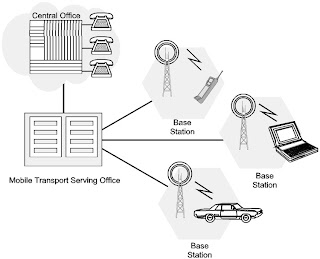Microwave system is always a Line-of-Sight
system which is based on the visibility between the Transmit End &
Receive End.
•It
is mandatory to avoid any physical obstruction in the line of sight
design.
•The
obstructions would include High rise buildings, Hillocks &
Vegetations like tall trees.
•To
overcome these obstructions we may have to increase the number of
towers or increase
the
height of the towers.
•The
microwave systems can operate in LOS mode for around a few hundred
meters to over 60 Km.
•So
it is imperative to determine the LOS over the complete hop length
between
he
Transmit end & Receive end
When
a microwave signal is sent it travels from the transmit end to the
receive end the signals take the form of an ellipsoid. The size of
ellipsoid depends on the frequency of operation. The higher the
operating frequency the smaller is the size of the ellipsoid. The
size of the ellipsoid is biggest at the center of the LOS. If any
obstruction is allowed into the fresnel zone, the obstruction will
reflect the signal. This reflected signal will cancel out and distort
the main signal thus reducing the strength of the main signal.
The
height of the LOS should be high enough to not permit any
obstructions to enter the fresnel zone.
The
microwave signals do not travel in a straight line but tend to travel
in a curved path following the curvature of the earth. The reason for
the effect is the refractive index of the atmosphere reduces with the
increase in altitude. This is known as the earth bulge factor
( k).
The
antenna is a device that converts the electrical signals into
the electromagnetic waves that propagate through free space.
In
Microwave systems the Standard Antenna used are Parabolic Antennas.
Antenna
gain is a measure of the antenna’s ability to transmit the waves in
a specific direction instead of in all direction.
Whats
with Microwave Radio Based System?
Series
875 LAN+T1 Microwave Radio System is a low cost, high bandwidth,
radio system capable of transporting full bandwidth LAN traffic and
T1 telephony up to 3 miles. The radio system offers the following
features:
The
Ethernet interface of the radio system supports all 802.3 protocols
and includes an AUI connection to network devices and BNC connections
to the microwave unit. The T1 data interface of the radio system
supports Bell Standard 100 ohm, two-wire twisted pair designed to
connect to telephony and multimedia interfaces. No on-site
programming is required and no additional test equipment is
needed.
The
Series 875 LAN+T1 system provides point-to-point connections for
hubs, bridges, routers and repeaters allowing full 10 Mbps Ethernet
connectivity. The 875 LAN+T1 interface has been designed to connect
directly to standard T1 PBX's, Channel Banks or Telecom Multiplexers
without the need for additional equipment.
The
Series 875 LAN+T1 is designed for rapid installation and alignment
without special tools or test equipment. Rugged, modular radio design
for ease of service and field support for years of trouble free
operation in harsh weather conditions.
Why
Microwave Radio Based Sytem?
Microwave Radio System offers the following features
|
Sources:
http://www.arcelect.com/Wireless_875_LAN+T1_23GHz.htm
http://www.ehow.com/list_6137210_microwave-radio-communications-advantages-disadvantages.html
nystec.com/files/Microwave.pdf
http://www.dpstele.com/dpsnews/techinfo/microwave_knowledge_base/microwave_system.php
Broadband
Telecommunications Handbook

microwave is vulnerable specially in area of communication that is not viable..Because of their high operating frequencies, microwave radio systems can carry large quantities of information.
ReplyDeleteMicrowave One-way (e.g. television broadcasting) and two-way telecommunication using communications satellite. and also helps to clear the reception of the tv. tnx for that blog keep it up
ReplyDeleteI see, the microwave signals do not travel in a straight line but tend to travel in a curved path following the curvature of the earth. nice info
ReplyDeleteAfter reading the features of the microwave radio system, i am pretty sure that this would be very effective and useful to the public..
ReplyDeleteThe major time delays for the microwave are usually in getting through the regulatory process in a governmentally controlled environment.
ReplyDeletenice blog. keep it up.
nice post very informative..
ReplyDeleteThe microwave signals do not travel in a straight line but tend to travel in a curved path following the curvature of the earth - thanks for the info..keep it up!
one of the great advantage of microwave radio is that microwave systems provide more reliable service than landlines, which are vulnerable to everything including flooding, rodent damage, backhoe cuts, and vandalism.
ReplyDeleteThe microwave systems can operate in LOS mode for around a few hundred meters to over 60 Km..
ReplyDeleteby the way..nice blog ..keep it pal ;)
a microwaves are widely used for point-to-point communications because their small wavelength allows conveniently-sized antennas to direct them in narrow beams, which can be pointed directly at the receiving antenna.
ReplyDeletewell perhaps pareng ding.. Microwave signal disruption EMI is caused by electric motors, electric power transmission lines, wind turbines, television/radio stations and cell phone transmission towers
ReplyDelete